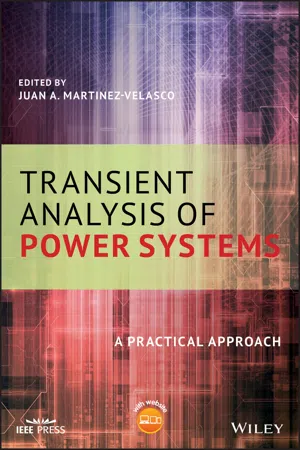
Transient Analysis of Power Systems
A Practical Approach
Juan A. Martinez-Velasco, Juan A. Martinez-Velasco
- English
- ePUB (mobile friendly)
- Available on iOS & Android
Transient Analysis of Power Systems
A Practical Approach
Juan A. Martinez-Velasco, Juan A. Martinez-Velasco
About This Book
A hands-on introduction to advanced applications of power system transients with practical examples
Transient Analysis of Power Systems: A Practical Approach offers an authoritative guide to the traditional capabilities and the new software and hardware approaches that can be used to carry out transient studies and make possible new and more complex research. The book explores a wide range of topics from an introduction to the subject to a review of the many advanced applications, involving the creation of custom-made models and tools and the application of multicore environments for advanced studies.
The authors cover the general aspects of the transient analysis such as modelling guidelines, solution techniques and capabilities of a transient tool. The book also explores the usual application of a transient tool including over-voltages, power quality studies and simulation of power electronics devices. In addition, it contains an introduction to the transient analysis using the ATP. All the studies are supported by practical examples and simulation results. This important book:
- Summarises modelling guidelines and solution techniques used in transient analysis of power systems
- Provides a collection of practical examples with a detailed introduction and a discussion of results
- Includes a collection of case studies that illustrate how a simulation tool can be used for building environments that can be applied to both analysis and design of power systems
- Offers guidelines for building custom-made models and libraries of modules, supported by some practical examples
- Facilitates application of a transients tool to fields hardly covered with other time-domain simulation tools
- Includes a companion website with data (input) files of examples presented, case studies and power point presentations used to support cases studies
Written for EMTP users, electrical engineers, Transient Analysis of Power Systems is a hands-on and practical guide to advanced applications of power system transients that includes a range of practical examples.
Frequently asked questions
Information
Chapter 1
Introduction to Transients Analysis of Power Systems with ATP
1.1 Overview
- 1. The selection of the study zone and the most adequate representation of each component involved in the transient. The system zone is selected taking into account the frequency range of the transients to be simulated: the higher the frequencies, the smaller the zone modelled. In general, it is advisable to minimize the study zone since a larger number of components does not necessarily increase accuracy; instead it will increase the simulation time and there will be a higher probability of insufficient or incorrect modelling. Although a high number of works has been dedicated to provide guidelines on these aspects [2–4], some expertise is necessary to choose the study zone and the models.
- 2. The estimation of parameters to be specified in the mathematical models. Once the mathematical model has been selected, it is necessary to collect the information that could be useful to obtain the values of parameters to be specified. Details about parameter determination of some power components were presented in [5]. A sensitivity study should be carried out if one or several parameters cannot be accurately determined. Results derived from such study will show which parameters are of concern.
- 3. The application of a simulation tool. The steadily increasing capabilities of hardware and software tools have led to the development of powerful simulation tools that can cope with large and complex power systems. Modern software for transient analysis incorporates friendly GUIs that can be very useful when creating the input file of the test system model.
- 4. The analysis of results. Simulation of electromagnetic transients can be used, among others, for determining component ratings (e.g. insulation levels or energy absorption capabilities), testing control and protection systems, validating power component representations or understanding equipment failures. A deep analysis of simulation results is an important aspect of the entire procedure since each of these studies may involve an iterative procedure in which models and parameters values must be adjusted.
